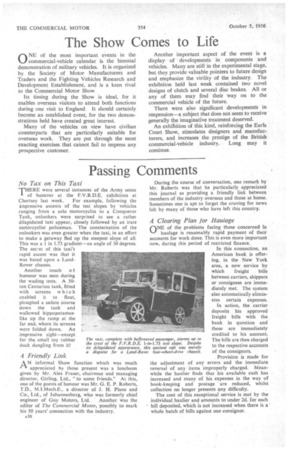Passing Comments
Page 32

Page 33

If you've noticed an error in this article please click here to report it so we can fix it.
No Tax on This Taxi
THERE were several instances of the Army sense of • humour at the F.V.R.D.E. exhibition at Chertsey last week. For example, following the impressive ascents of the test slopes by vehicles ranging from a solo motorcyclist to a Conqueror Tank, onlookers were surprised to see a rather dilapidated taxi appear, closely followed by an irate motorcyclist policeman. The consternation of the onlookers was even greater when the taxi, in an effort
Another touch o t humour was seen during the wading tests. A 50ton Centurion tank, fitted with screens which enabled it to float, ploughed a sedate course down the tank and wallowed hippopotamuslike up the ramp at the far end, where its screens were folded down. An impressive sight—except for the small toy rubber duck dangling from it!
4 Friendly Link
AN informal Show function which was muCh appreciated by those present was a luncheon given by Mr. Alex Fraser, chairman and managing director, Girling, Ltd., " to some friends." At this, one of the guests of honour was Mr. G. E. P. Roberts, TD., M.I.Mech.E., a director of J. H. Plane and Co., Ltd., of Johannesburg, who was formerly chief engineer of Guy Motors, Ltd. Another was the editor of The Commercial Motor, possibly to mark his 50 years' connection with the industry.
During the course of conversation, one remark by Mr. Roberts was that he particularly appreciated this journal as providing a friendly link between members of the industry overseas and those at home. Sometimes one is apt to forget the craving for news felt by many of those who have left this country.
A Clearing Plan for Haulage
ONE of the problems facing those concerned in haulage is reasonably rapid payment of their accounts for work done. This is even more important
now, during this period of restricted finance.
In this connection, an American bank is offering, in the New York area, a new service by which freight bills between carriers, shippers or consignees are immediately met. The system also automatically eliminates certain expenses.
In action, the carrier deposits his approved freight bills with the bank in question and these are immediately credited to his account. The bills are then charged to the respective accounts of the consignors.
Provision is made for the adjustment of any errors and the immediate reversal of any items improperly charged. Meanwhile the haulier finds that his available cash has increased and many of his expenses in the way of book-keeping and postage are reduced, whilst collection no longer presents any difficulty.
The cost of this exceptional service is met by the individual haulier and amounts to under 2d. for each bill deposited, which is not increased when there is a' whole batch of bills against one consignor.
An Historic Occasion
nNE of the most pleasant functions arranged to coincide with the advent of the Commercial Motor Show was the recent London tour organized by the Omnibus Society, in conjunction with the London Transport Executive.
From Charing Cross Underground station, two 56-seat RT.-type buses took the party to Charlton, via the City, Minories bus station, Tower Bridge, Dockland, Rotherhithe Tunnel and the Woolwich Free Ferry.
After an inspection of the Charlton works, the party were shown the British Transport Commission's Museum of Historic Vehicles. Items of special interest here included, amongst others, a Chesterfield Corporation single-deck tram (1897); a double-deck Douglas Corporation horsed tram (1876); a Northern General single-deck bus, No. 604, with side engine (1934), and a K. and E.S.R. station bus (circa 1903).
At Reigate—the southern divisional headquarters of the country-bus section of L.T.E.—the party was joined for lunch by Mr. •J. B. Burnell, C./3.E., J.P., M.Inst.T., operating manager, central road services, L.T.E., president of the Society.
All stages of progress in the evolution of London Transport road vehicles were then shown to the visitors. These included a replica of the Shillibeer horsed bus, trams, doubleand single-deck buses, and the first trolley bus.
The return journey to Stockwell, via Epsom and Leatherhead, took the party past Chessington Zoo for a glimpse of the tramcar at the gates, an 1858 HR/2 type operated in London.
After tea in the canteen, a tour of the Stockwell garage followed. Opened in 1952, this is constructed of reinforced precast concrete, and is equipped with many labour-saving devices to facilitate maintenance tasks.
This comprehensive London tour terminated at Victoria (Gillingham Street) garage, the home of airport coaches operated by London Transport on behalf of British European Airways.
















































































































